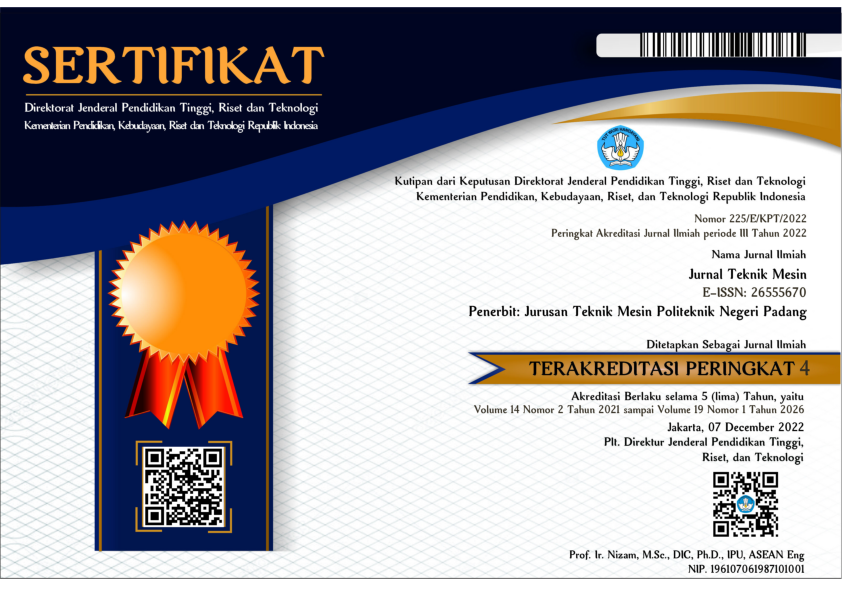Experimental and Numerical Evaluation of Mechanical Properties for Carbon Fiber Reinforced Epoxy LY5052 Composite for Prosthesis Structures
Abstract
Carbon Fiber Reinforced Epoxy is a material that is widely used in the manufacture of prosthesis structures. In this research, the carbon fiber used is plain weave-type carbon, while the matrix used is LY5052 epoxy, LY5052 epoxy has advantages such as low viscosity and long pot life making it possible to manufacture large-sized prostheses. The first step in this research is making specimens using the vacuum infusion method and then cutting the specimens with dimensions referring to ASTM D3039. Furthermore, tensile test experiments were carried out with the results obtained that the maximum stress (?) was 537.15 MPa. As an evaluation, a tensile test simulation was carried out with Finite element analysis using Abaqus software, the material properties used were the results of a tensile test experiment, in the process the mesh selection was carried out by input sizing control many times this was done to determine the accuracy of the results. The tensile test simulation results with abaqus software are 523.3 MPa when compared to the experimental, the difference is only 2.58%. based on experimental and simulation results, the mechanical properties of the Carbon Fiber Reinforced Epoxy LY5052 Composite material are almost the same, so that in the manufacture of prosthesis the mechanical properties data in this study can be used when performing numerical analysis in the prosthesis design process.
References
https://www.docdoc.com/id/info/condition/prostesis. accessed on April 28, 2022
Baptista, R., Mendo, A., Guedes, M., & Marat-Mendes, R. 2016. An experimental study on mechanical properties of epoxy-matrix composites containing graphite filler. Procedia Structural Integrity, 1, 74-81.
Oktaviameta, A., Kardiman, K., & Suci, F. 2021. Pengaruh Fraksi Volume Serat Jerami Terhadap Kekuatan Material Komposit Aplikasi Kayu Lapis. Jurnal Teknik Mesin, 14(2), 70-74. https://doi.org/10.30630/jtm.14.2.568
Cho, J., Chen, J.Y. and Daniel, I.M., 2007. Mechanical enhancement of carbon fiber/epoxy composites by graphite nanoplatelet reinforcement. Scripta Materialia 56, 685688
S. Saseendran, M. Wysocki and Janis Varna., 2017 Cure- state dependent viscoelastic Poissons ratio of LY5052 epoxy resin, Advanced Manufacturing: Polymer & Composites Science, 3:3, 92-100, DOI:10.1080/20550340.2017.1348002
Technical Data Sheet epoxy LY5052 https://www.generaladhesivos.com/proveedorpegamento/909hoja-tecnica-Araldite%20LY%205052 accessed on June 02, 2022
ASTM D3039 / D7264M-15, Standard Test Method for Tensile Properties of Polymer Matrix Composite Materials, ASTM International, West Conshohocken, PA 19428-2959, 2002
FiberGlast., 2015. Vacuum Infusion - The Equipment and Process of Resin Infusion Introduction.
Autar K Kaw., 2006. Mechanics of Composite M
A. F. Istiqomah, et al., 2021. Design and Analysis of The Energy Storage and Return (ESAR) Foot Prosthesis Using Finite Element Method, Journal of Biomedical Science and Bioengineering (JBIOMES) 1 (2), page 5964.
M. Y. Khalid, et al., 2020. Experimental and numerical characterization of tensile property of jute/carbon fabric reinforced epoxy hybrid composites. SN Applied Sciences, 2(4). doi:10.1007/s42452-020-2403-2.
K. Karthik, D. Rajamani, T. Raja et al., 2022. Experimental investigation on the mechanical properties of Carbon/Kevlar fibre reinforced epoxy LY556 composites, Materials Today: Proceedings, https://doi.org/10.1016/j.matpr.2021.10.077
Nirbhay, M., Dixit, A., Misra, R. K., & Mali, H. S., 2014. Tensile Test Simulation of CFRP Test Specimen Using Finite Elements. Procedia Materials Science, 5, 267273. doi:10.1016/j.mspro.2014.07.266.
Krucinska, and Stypka., 1991. Direct measurement of the Axial Poissons Ratio of Single Carbon Fibres. Composites Science and Technology, 41(1), 112. doi:10.1016/0266-3538(91)90049-u.
A. P. Kurniawan, T. P. Soemardi, Widjajalaksmi, 2009. Komposit Laminate Rami Epoksi Sebagai Bahan Alternatif Socket Prosthesis. JURNAL TEKNIK MESIN Vol. 11, No.1, April 2009: 4145
Memahami Nilai Standard Deviation (Standar Deviasi) Dalam Penelitian Ilmiah. https://accounting.binus.ac.id/2021/08/12/memahami-nilaistandard-deviation-standar-deviasi-dalam-penelitian-ilmiah/. accessed on April 29, 2022
Kurva Tegangan Regangan (Stress-Strain Curve) Pada Uji Tarik. https://www.etsworlds.id/2020/01/kurva-teganganregangan- stress-strain.html accessed on April 29, 2022













